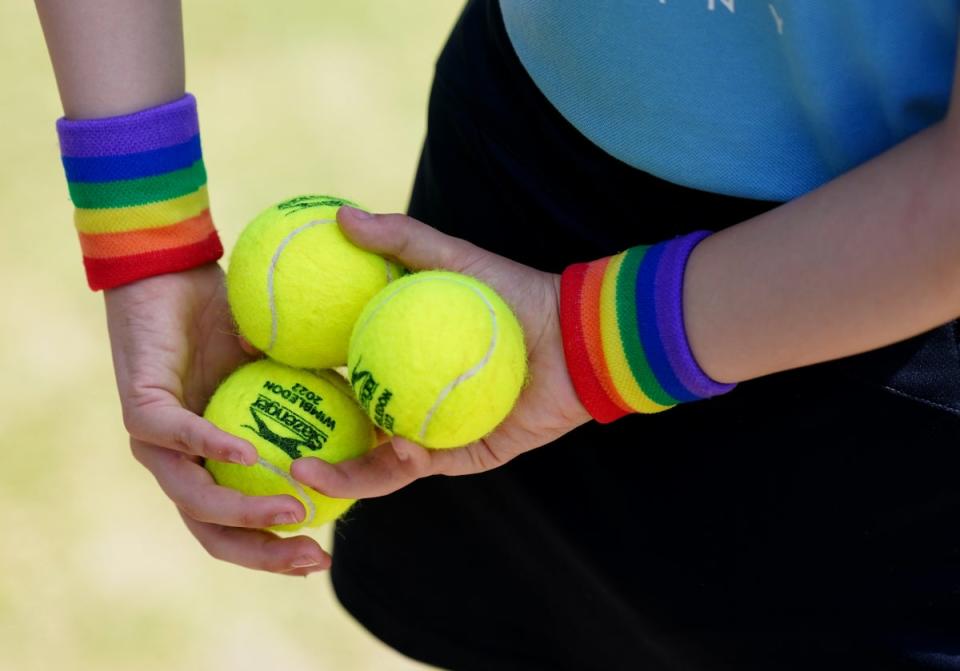Pride in Tennis optimistic Wimbledon will join bid to make sport more inclusive

Ian Pearson-Brown is spearheading a drive towards inclusion through Pride in Tennis and hopes Wimbledon will soon be on board.
The organisation launched in February with a vision of making tennis a safe and inclusive environment for all LGBTQI+ people and has partnered with the Lawn Tennis Association to put on Friday Pride Days at the grass-court tournaments at Nottingham, Birmingham, Queen’s and Eastbourne.
Fans, players, officials and volunteers have been encouraged to wear bright colours and display the rainbow flag to celebrate Pride Month.
The visibility and awareness at todays Nottingham Open was fantastic. Officials wearing wristbands, discussions on how to get the local LGBTQ+ population involved in Tennis, a progress flag fluttering in the background and even a message from 🌈ally @Liambroady #fridayprideday https://t.co/kkQHBxNQUl pic.twitter.com/pM6z5CLpn5
— Pride in Tennis (@pride_tennis) June 10, 2022
“It was really heartening to be sat on the centre court (in Nottingham) with Progress Pride flags fluttering in the background and being able to step onto the court and talk positively about the steps we’re taking to open up the sport,” Pride in Tennis founder Pearson-Brown told the PA news agency.
The US Open and Australian Open have both held Pride Days, while the Glam Slam, an LGBTQI+ tennis event, takes place at Melbourne Park each January.
Pearson-Brown is optimistic Wimbledon will follow suit, saying: “All we know at the moment is some of the Wimbledon officials have been looking at what the LTA have been doing at the grass-court events and there are likely to be plans under way but we don’t know as yet what those plans will look like.”
Pearson-Brown’s own experiences growing up as a player and then coach in Newcastle inspired him to set up Pride in Tennis.
I thought the sporting environment in general wasn't a space where gay men existed.
Ian Pearson-Brown
“I was a typical Geordie sports-mad kid and I found when I was 13 that I was gay,” he said.
“I thought the sporting environment in general wasn’t a space where gay men existed. I hid my sexuality and it caused me a lot of mental health problems, including attempts on my own life.
“And when I was 30 it was the last environment I came out in. A lot of the fears I had were internal. I presumed that parents would take their kids away from my sessions if they found out the coach was gay. I assumed a lot of my team-mates wouldn’t find it an acceptable thing. And actually that wasn’t the case.
“And that’s when I realised I wanted to give something back. I wanted to try and spread the word a bit, increase visibility but mainly just talk about the fact that tennis is quite a good space to be in if you’re LGBTQI+ and you absolutely can be gay and be a coach or a player or an official or a volunteer.”
Love is love 🌈❤️
Welcome to AO Pride Day!#AOPride · #Unitedbypride pic.twitter.com/94jvT0UoHE— #AusOpen (@AustralianOpen) January 23, 2022
As well as increasing visibility at high-profile events, Pride in Tennis aims to boost participation at grass-roots level, including by helping venues around the country set up LGBTQI+ friendly groups, and educate the wider tennis community around inclusivity.
Pearson-Brown has been encouraged by the support Pride in Tennis has received from tennis’ governing bodies, including the LTA, which has made opening the sport up its central strategy.
“I initially contacted the LTA about eight years ago,” said Pearson-Brown. “They weren’t in the right place for that type of conversation around visibility. They didn’t see the barriers, they didn’t understand it.
“We’ve had some really positive discussions. There’s a lot of change in attitudes, people are listening to the concerns that myself and many other LGBTQI+ people who are involved in tennis had about the fact enough hadn’t been done.”
Fridays at each of our grass court events this month will become ‘Friday Pride Days’ in celebration of LGBTQ+ Pride Month.
Read more 👇— LTA (@the_LTA) June 1, 2022
One area Pearson-Brown remains concerned by is the lack of out male professional players.
Citing the example of Blackpool footballer Jake Daniels, who was widely praised for revealing he is gay in May, Pearson-Brown expressed hope that tennis can be seen as a safe space whatever a player’s sexuality.
“No doubt there have been some male players who have gone through their tennis career and hidden their sexuality, and they will probably not have achieved as much as they would have done,” he said.
“We need to just try and work at grass-roots level to try to create that environment and hope those role models like Jake Daniels will emerge in tennis as well.
“It’s not just tennis’ problem, it’s every major sport you can think of. It’s embarrassing when you consider most studies on Gen Z (10 to 25-year-olds) show that between 10 and 15 per cent of the population thinks they may be LGBTQI+, yet there are more (LGBTQI+) people in countries where it’s illegal to be gay and you can be stoned or beheaded than there are in the men’s games of all major sports. It’s incredible to say that in 2022.”

